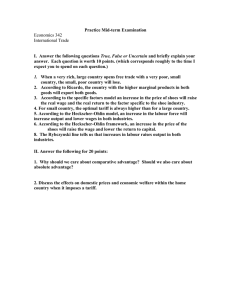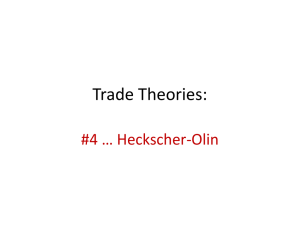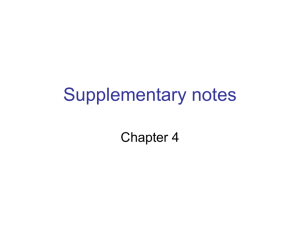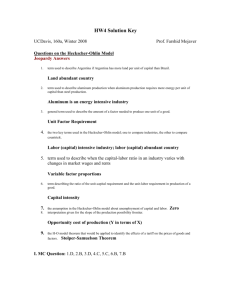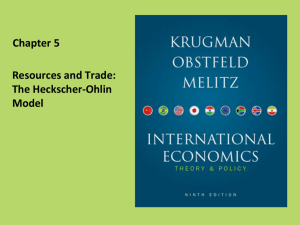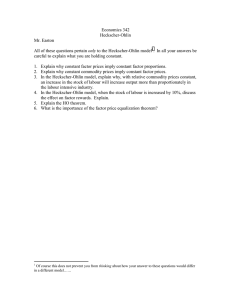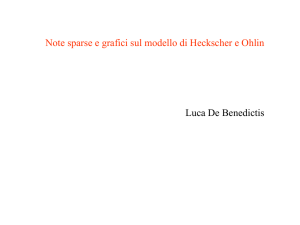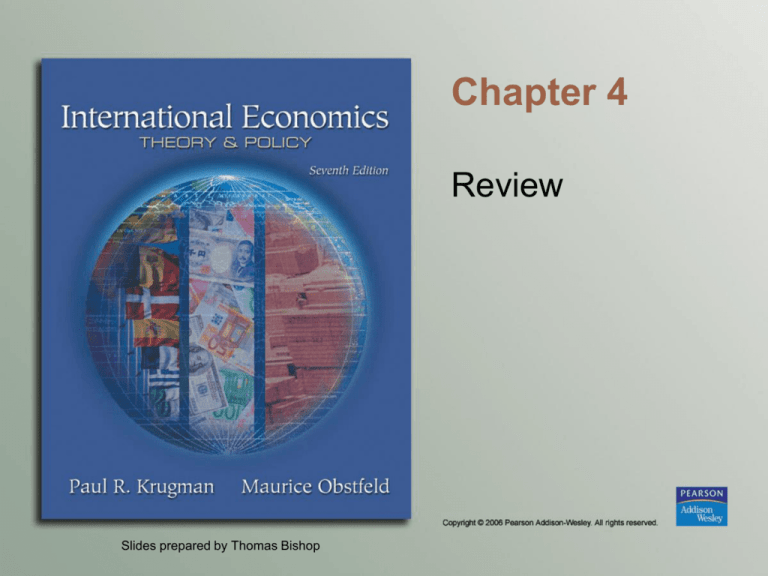
Chapter 4
Review
Slides prepared by Thomas Bishop
Production Possibilities (cont.)
Production and Prices (cont.)
Factor Prices, Goods Prices
and Factor Levels (cont.)
Factor Prices, Goods Prices
and Factor Levels (cont.)
Factor
Prices,
Goods
Prices
and
Factor
Levels
(cont.)
Factor Prices, Goods Prices
and Factor Levels (cont.)
• We have a relationship among factor prices and good prices and
the levels of factors used in production:
• Stolper-Samuelson theorem: if the relative price of a
good increases, then the real wage (or rate of return
of the factor) used intensively in the production of that
good increases, while the real wage (or rate of return
of the other factor) decreases.
– Pc/PF up (T/L)C up; (T/L)F up.
– Marginal productivity of a factor increases as the level of that
factor used in production decreases: L down MPL up.
– Under competition, the real wage/return is equal to the
marginal productivity of the factor: W/Pc=MPL
– Pc/PF up W/Pc up, W/PF up ;r/Pc down, r/PF down
Factor
Prices,
Goods
Prices,
Factor
Levels
and
Output
Levels
(cont.)
Factor Prices, Goods Prices,
Factor Levels and Output Levels
(cont.)
Key Points:
• Increase of total factor endowments (capital, labor)
cannot affect factor return (rent, wage) in the 2-sector
economy.
• Different from one-sector economy( depends on MP).
• Because the labor-abundant country can produce more
of, and export, the labor-intensive good.
• It can fully employ its labor while still paying the same
wages as a capital-abundant country.
• However, increase of price ratio, of course, affect
industrial output share.
Production Possibilities (cont.)
An Example
• When the relative price of cloth
increases, output of cloth
increases. Also, K/L ratio in
each industry increases as
well.
• Example due to Pc up
• C=KL; F=f(K,L)
• Total labor=200, total K=30
• C is labor intensive; F is capital
intensive.
• S-S theorem: (K/L) increase in
both industry; Cloth industry
expands while food shrinks.
K
L
10
100 20
160
1/10
1/8
100 10
40
1/5
1/4
0
C
F
20
0
KN
LN
Trade in the Heckscher-Ohlin Model
• Suppose that the domestic country has an abundant
amount of labor relative to the amount of land.
– The domestic country is abundant in labor and the foreign
country is abundant in land: L/T > L*/ T*
– Likewise, the domestic country is scarce in land and the foreign
country is scarce in labor.
– However, the countries are assumed to have the same
technology and same consumer tastes.
• Because the domestic country is abundant in labor, it will
be relatively efficient at producing cloth because cloth is
labor intensive.
Excess Demand of Cloth when Autarky Price is the Same
Trade in the Heckscher-Ohlin
Model (cont.)
Trade in the Heckscher-Ohlin
Model (cont.)
Factor Price Equalization
• Unlike the Ricardian model, the Heckscher-Ohlin
model predicts that factor prices will be equalized
among countries that trade.
• Because relative prices are equalized and because of
the direct relationship between relative prices and
factor prices, factor prices are also equalized.
• Empirical Evidence
Copyright © 2006 Pearson Addison-Wesley. All rights reserved.

